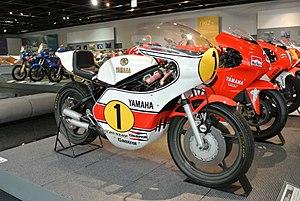Yamaha YZR500
Appearance
(Redirected from YZR500)
This article needs additional citations for verification. (October 2010) |
 1975 Yamaha YZR500 (OW23) | |
| Manufacturer | Yamaha Motor Company |
|---|---|
| Production | 1973–2002 |
| Predecessor | Yamaha YZ634A |
| Successor | Yamaha YZR-M1 |
| Engine | two-stroke OW23: 494.7 cc (30.19 cu in) inline-4 OW54: 498.5 cc (30.42 cu in) U engine OW61: 498.5 cc (30.42 cu in) 60° V4 OWK1: 494.7 cc (30.19 cu in) 70° V4 |
| Bore / stroke | 54 mm × 54 mm (2.1 in × 2.1 in) 56 mm × 50.6 mm (2.20 in × 1.99 in) |
| Power | 0WL9: 142 kW (190 hp) @ 10,500 rpm |
| Related | Yamaha TZ750 |
The Yamaha YZR500 was a 500 cc Grand Prix racing motorcycle made by Yamaha from 1973 to 2002. It achieved significant acclaim, especially during the 1980s and 1990s.

Racing history
[edit]The YZR500 was ridden by championship winners Giacomo Agostini (1975), Kenny Roberts (1978, 1979, 1980), Eddie Lawson (1984, 1986, 1988) and Wayne Rainey (1990, 1991, 1992).
Phillip McCallen won the Macau Grand Prix in 1996.
Chronology
[edit]| Year | Model | Constructors' championship |
|---|---|---|
| 1973 | 0W20: Liquid-cooled, inline-4, two-stroke engine, chromoly frame. Yamaha's first 500cc factory bike won from the outset at the first round of the 1973 season, ridden by Jarno Saarinen. | 2nd |
| 1974 | 0W23: Yamaha's first machine created specifically for 500cc racing. Yamaha won their first 500cc constructors' championship with it and in 1975 Giacomo Agostini rode the 0W23 to a world championship as well as giving Yamaha their second 500cc constructors' championship. | 1st |
| 1975 | 1st | |
| 1976 | For 1976 as the factory Yamaha team was dismantled, the 0w23 was handed to Venemotos for Johnny Cecotto, but Cecotto soon discarded the 500 because it was obsolete compared to the factory Suzuki and even to the RG Mk1 production racers. | 2nd |
| 1977 | 0W35: Changes were made to the valve intake system, stroke ratio, and carburetor. | 2nd |
| 0W35K: Introduction of Yamaha's Power Valve System (YPVS). Kenny Roberts won his first of three championships with it. | ||
| 1978 | 2nd | |
| 1979 | 0W45 | 2nd |
| 1980 | 0W48: Introduction of an aluminum frame to the YZR500. | 2nd |
| 0W48R: At round 4 of the season, the YZR500 returned to a steel frame, and the engine had the outer cylinders reversed and thus rear-directional exhaust. | ||
| 1981 | 0W53: Same rear-directional exhaust as the 0W48R, and the aluminum frame used a squared cross-section. Last inline-4 YZR500. | 2nd |
| 0W54: Square-4 engine, rotary disc valve. | ||
| 1982 | 0W60 Updated square-4 machine | 2nd |
| 0W61: The first Japanese V4 engine in a 500cc Grand Prix motorcycle. Also had a new frame structure that was the basis for the Deltabox frame, which was developed by Spanish engineer Antonio Cobas.[1] | ||
| 1983 | 0W70: Introduction of the aluminum Deltabox frame and designed specifically for a 17-inch front wheel (from 18 inches). | 2nd |
| 1984 | 0W76: Crankcase reed valve system. Eddie Lawson wins the rider championship with it. | 2nd |
| 1985 | 0W81: Re-designed V-4 engine. Eddie Lawson won the riders' championship with it. | 2nd |
| 1986 | 1st | |
| 1987 | 0W86: Improvements to the exhaust and cooling systems. | 1st |
| 1988 | 0W98: A new exhaust layout of both pipes going under the engine and out the right side required an asymmetrical swingarm. Eddie Lawson won the riders' championship on it. | 1st |
| 1989 | 0WA8: Introduction of a data-recording device. | 2nd |
| 1990 | 0WC1: Wayne Rainey won his first riders' championship on it. | 1st |
| 1991 | 0WD3: New regulation came into effect: the minimum weight would be 131 kg (for the four cylinders bikes). Yamaha used in this year first (and last) chip controlled suspension (CES). | 1st |
| 1992 | 0WE0: In the latter half of the season, Yamaha introduced their own "big-bang" firing order to the YZR500. Third championship for Wayne Rainey. | 2nd |
| 1993 | 0WF2: An extruded aluminum frame was designed to resist flex from increased power output, though Wayne Rainey complains that it is too stiff, and in round 8 Rainey switches to a chassis used by Team ROC. | 1st |
| 1994 | 0WF9: Re-design of the fairing and introduction of ram-air intake. | 3rd |
| 1995 | 3rd | |
| 1996 | 0WJ1: New alloy for the engine and new design for the frame. | 2nd |
| 1997 | 0WH0: The "V" was widened to allow a larger air box. The 0WJ1 and 0WH0 were developed simultaneously and used in reverse order during the season. | 2nd |
| 1998 | 0WK1: Move to unleaded fuel. | 2nd |
| 1999 | 2nd | |
| 2000 | 0WK6: General improvements to the engine, frame and cowl. | 1st |
| 2001 | 0WL6 | 2nd |
| 2002 | 0WL9: The 28th and last generation of the YZR500 had to compete against the newly allowed 990cc 4-stroke machines. | 2nd[2] |
See also
[edit]Notes
[edit]- ^ Adams, Dean. Antonio Cobas Dead at 52 Archived 2010-08-30 at the Wayback Machine Superbikeplanet.com 2004.
- ^ All but 10 points that counted towards the Constructors' championship were scored by Yamaha's YZR-M1 4-stroke machine
External links
[edit]- Official Yamaha page for the history of the YZR500 (in Japanese)
